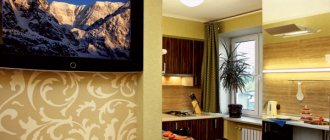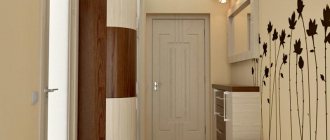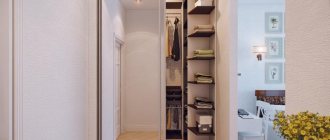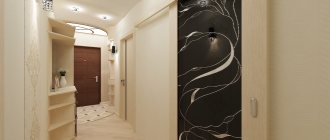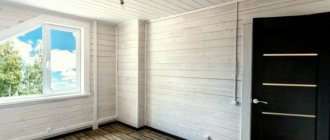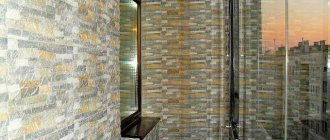Advantages of using decorative stone
This method owes its popularity to the presence of a number of advantages, such as:
- Affordable price.
- Large selection of models.
- Beautiful interior style.
- Combines perfectly with other finishing materials.
- Does not require preliminary preparation of the wall.
- The surface of the material is resistant to moisture.
In addition to all these features, it is quite difficult to damage such a coating - the structure of the stone is strong and resistant to mechanical stress.
Features of interior decoration
The choice of decorative coating is not the only issue that the master needs to decide before starting work.
Before decorating the walls with stone in the hallway, it is worth calculating the square footage of the room, the required amount of stone and auxiliary building materials.
When working with expensive and complex relief types of stone, it is worth getting specialist advice or using the services of a professional interior finishing specialist.
The steps to decorate the hallway include the following steps:
- Preparation of material and tools.
- Dismantling the old covering.
- Alignment of walls.
- Surface priming.
- Laying stone.
Decorating the hallway walls with decorative stone is an activity that requires clarity and a strict procedure. By performing all actions strictly according to the scheme, you can achieve an excellent result without disturbing the overall style of the interior in the hallway.
“You meet people by their clothes...”
The hallway is often unfairly ignored when people think about the design of an apartment. But, as the proverb says, “they are greeted by their clothes,” and the hallway is the first place where the owners and guests find themselves.
The hall combines many functions. Here they store outerwear and shoes, various accessories for going out, and arrange dressing areas. In addition, many families are forced to provide space in the hallway for children's things - strollers, bicycles, scooters and toys.
Hallway with brick walls and wallpaper with trees
Thus, the requirements for the hallway interior become very high. For the sake of practicality, design is often forgotten. And they make a mistake - because the impression of the entire apartment depends on how the hall looks.
Preparation of material and tools
When purchasing decorative stone, you should immediately stock up on the following tools that will be needed when carrying out repair work:
- Hacksaw or grinder (depending on what type of stone will be used).
- A set of spatulas of various sizes and shapes.
- Construction level to control the even laying of the coating.
- File for grinding parts of stone.
- Varnish and paint brushes (acrylic varnish will create a glossy shine and an additional protective layer on the surface of the coating).
- Primer for walls.
- Glue (it is better to choose gypsum or cement based types).
Auxiliary tools such as a pencil and a ruler for marking stone parts can be prepared as you go.
How to stick
Gluing decorative stone to wallpaper, be it artificial or natural, has become quite popular. All the work can be done with your own hands, independently. On the other hand, to solve such problems, an inexperienced person needs to read, at a minimum, brief instructions, as well as read certain recommendations. First, let's say a few words about the different types of wallpaper that can be used to combine them with a stone surface:
- Light wallpaper made of paper. They can consist of either one or two layers. In a certain sense, the disadvantage of such wallpaper is that when glue gets on it, it gets wet and loses its strength.
- The so-called heavy wallpaper, which includes vinyl and non-woven fabrics. When gluing stone to vinyl and non-woven wallpaper, there is no guarantee that it will stick well and for a long time.
- Liquid wallpaper for stone. This type of wallpaper is such only nominally, by its name. In fact, in terms of the structure of the material and the method of application, they are much closer to plaster.
Thus, it becomes clear that gluing decorative stone to wallpaper is not so simple. For this reason, it is necessary to look for some other solutions. Let's see what can be done in such situations and what seems to be the most rational solution.
Effective methods
What is the best way to carry out installation? Let's see what possibilities there are for this.
First of all, we can remind you that you can first hang wallpaper. Nevertheless! Although they are glued along the entire perimeter, you will need to leave free those areas on top of which the stone (natural or artificial) will then be installed. At the same time, you should not forget that the working surface of the wall must be prepared both before wallpapering and before installing decorative stone. In any case, the fastening of the artificial stone is carried out after the wallpaper has been pasted.
Remember! With this method, installation is carried out not on top of the wallpaper, but on those areas of the wall that remain clean.
For proper installation, you first need to measure and outline the areas on which the decorative panels will subsequently be glued.
But what to do in cases where the wallpaper is already pasted? As we can see, gluing decorative stone on top of wallpaper is not the best idea. What can be done in such circumstances? In fact, this task is not so insurmountable, although it requires accuracy.
So, here's a quick guide to what you need to do:
- You will need a simple or construction pencil, with which you will need to mark the places where the stone will subsequently be glued.
- Take a blade or sharp knife and cut out these areas, then remove the layer of wallpaper.
- At the same time, do not forget that you will need to combine the wallpaper and the stone with an overlap, and not butt. That is, you will need to leave a few extra millimeters. As a result, the edge of the stone panel should cover the end of the wallpaper outline.
- Then the glue is prepared and the stone decorative slabs are glued, according to the instructions.
- To complete the work, you can treat the stone with a special varnish. This colorless substance serves as additional protection and extends the life of the decorative coating.
However, this technology is not the only one. The fact is that you can put natural or artificial stone even before you hang the wallpaper itself. In other words, decorative panels need to be glued first. The main feature to take into account is that when installing stone panels, you will need to leave the end stones uncovered. The fact is that they should border on the wallpaper. So: you can stick them on only when you install the wallpaper. And don’t forget about the small “overlap” that we wrote about just above.
If we are talking about liquid wallpaper, then it is worth remembering that they have nothing to do with traditional rolls except for the name. Do you want to stick decorative stone on top of liquid wallpaper? Take your time because this is not worth doing. It is better to install both coatings separately so that they do not overlap each other. About the same as with ordinary wallpaper. Good luck with the renovation! Photo catalog with examples of interiors (click to enlarge):
- How to glue the walls in the corridor.
- Photo wallpaper in the living room interior.
Preliminary leveling of walls
This procedure is necessary so that the decorative stone fits better and more evenly on the underlying base.
All minor defects (small cracks, gaps) are covered with a layer of putty. Larger irregularities or construction defects are plastered.
Particular attention should be paid to surfaces near door jambs - this is where deep cracks most often form over time.
Priming the walls
The next step is to apply 1-2 layers of primer to the surface of the walls. This must be done for a number of reasons:
- Preliminary priming of the surface allows you to get rid of dust and dirt.
- In this way, additional stickiness of the underlying layer is created.
- The primer protects the walls from the possible development of fungal colonies.
Thus, this procedure can significantly increase the service life of the decorative coating.
- Window sill on the balcony - 165 photos of modern ideas and options for using window sills
Tile in the hallway: stylish, beautiful and creative tile options (video + 170 photos)
Kitchen backsplash tiles - design ideas and the best examples of using tiles (165 photos + video)
Laying decorative stone
To create a more natural and original pattern, it is better to lay the covering elements in different directions so that adjacent seams do not have the same course. Sequence of finishing work:
- Diluting the glue (the method will depend on the type of glue and its base). It is better to prepare the working solution strictly according to the instructions, and then the glue will hold the decorative stone more firmly.
- First row location. It is customary to start work from the corner of the wall (top or bottom - it doesn’t matter).
- A layer of glue is applied to each fragment using a notched trowel.
- The stone element is pressed against the wall surface, aligned in the direction of the seam and excess glue is removed.
For ease of work, you can use a ready-made diagram for laying decorative stone. You should also familiarize yourself with the various options for finishing the hallway with stone, which will help you understand the progress of laying the covering elements.
Shades of Gray
The gray color imparts rigor, and the hallway, made in shades of this color, speaks of the practicality and efficiency of the owner of the house. The shades can be combined with other components to achieve a fresh, modern look.
In the Gothic trends of the Middle Ages, you can diversify the style of the hallway with the help of laying gray, red and black bricks and additional accessories.
Types of decorative stone for the hallway
On the building materials market you can find a fairly rich selection of materials: natural and artificial options.
More preference is given to artificial materials, since natural stone has a high cost and requires the help of a specialist to carry out repairs.
Stone wallpaper (video)
They have many advantages over conventional wallpaper, including cheaper cost and a wider range. Choosing stone wallpaper or decorative stone is a rather hectic matter that requires a lot of attention and concentration. Don’t be shy to seek help from a specialist. Any nuance must be resolved in advance. You should immediately decide who will glue the wallpaper. It is not recommended to glue stone wallpaper yourself for the first time; it is better to entrust this task to professionals. Stone wallpaper is a worthy solution for the interior and will provide the home with comfort, warmth and sound insulation. With stone wallpaper, boredom will leave the house, because stone is a symbol of unusualness and strength of character.
Advantages of artificial material
Before you make your choice, you should find out all the advantages of finishing with artificial stone:
- Relatively low price.
- Light weight, which reduces the load on wall supports.
- There are no special care or cleaning requirements.
- Does not fade under the influence of sunlight.
- Wide selection of models in color, texture and shape.
This type of decorative stone has earned particular popularity among apartment owners and interior decorators due to the ease of repair work.
- Hanger in the hallway: 185 photos of modern ideas for the design and use of hangers
- Paintings for the living room: beautiful and modern trends in the placement of paintings (135 photos and videos)
Buying porcelain tiles: instructions on how to choose, where to buy, which one is better
Painting methods
When choosing a type of product, you should pay attention to the painting method. If you add pigment to the solution when preparing it, this will allow you to lay out the tiles in the same tone. Then you need to paint the surface with a tint color. This will give it a more natural look. This technology is aimed at eliminating noticeable differences in tones, even if chipping occurs. Shades that are similar in color allow you to hide defects that arise over time.
Stonework in one tone.
Another type of painting involves applying pigments only to the surface. But if chips appear, they will be noticeable. This is due to the strong difference in color.
Painting with the application of pigments only to the surface.
Cement-based decorative stone
This coating option is particularly durable and resistant to moisture. The surface of walls finished with cement stone is easy to clean without fear of residual contamination. For finishing the hallway, cement elements will be an excellent solution.
In addition, the stores offer the buyer a huge assortment of design ideas.
But when choosing this material, it is worth remembering the negative aspects of stone: heavy weight, difficulties when cutting and polishing building blocks. Before laying the covering, additional strengthening of the walls is required.
Where is it used?
It must be said that the scope of application of decorative stone in the interior of premises for various purposes is quite wide. You can place decorative stone, especially in addition to other materials, in many places. Here is just a short list of rooms and premises:
- Hallway.
- Living room.
- Kitchen.
- Bedroom.
- Loggia.
- Retail premises.
- Halls and foyers of office buildings.
Depending on what exactly the buyer/customer likes best, various options for decorating the interior space of the hallway and other rooms with stone can be used:
- As the main finishing material.
- As one of the auxiliary coatings when combining different types of finishes.
In addition, in addition to wall decor, artificial stone has another opportunity for use in the interior of rooms. We are talking about finishing the ceilings, usually partial. It is used as an additional measure to give the room a more finished look. Of course, it is difficult to imagine the ceiling of a room being completely finished using stone finishing. However, if we talk about fragmentary use, then it is quite acceptable.
Attention! Do not forget that different materials must be successfully combined, including color.
Almost everyone knows that stone finishing does not suffer from fungus or mold, unlike some other types of finishing coatings, and is also not afraid of corrosion or mechanical damage. In addition, this material, which can be used as a companion when finishing interior walls and partitions, is also distinguished by the fact that it is able to provide the highest level of environmental safety. This makes it possible to place such material in any living room, since it is absolutely safe for human health: both adults and children.
Decorative sandstone stone
This model is classified as a flexible type of stone. For finishing, you can cut a very thin layer of material, which is quite easy to lay on the wall.
With the help of sand stone, it is possible to create a pleasant interior with natural shades and beautiful patterns. The only drawback is that the layers of stone should only be glued onto the underlying textile base.
Shades of white
White color contributes to the visual expansion of space; its use in design is considered a classic. The choice of shades of a given color is the key to success, as connoisseurs of sophisticated style know. Some people think that white is a very easily soiled color, which is bad for the hallway, but this is not true, because the stone is very easy to keep clean.
There is no need to make all the interior details of the hallway white; it is best to dilute the space with bright accessories such as a carpet or lamps.
Plain white walls are a must for the Greek style. If you want to recreate it at home, white can be alternated with shades of blue and blue.
Stone in the form of clinker tiles
Such decorative coating models are made from certain types of clay. The creation technology involves firing finishing elements in a kiln to form a natural relief pattern.
The thickness of each stone does not exceed 2.5-3.0 cm, which greatly simplifies the process of working with this model.
Decorative stone made of gypsum
This model has a number of advantages that determine the popularity of the material:
- Low cost.
- Light weight material.
- Ease of practical application.
Unfortunately, there were some drawbacks:
- The coating does not tolerate high indoor humidity.
- After laying the stone, 2-3 layers of acrylic varnish must be applied to the surface.
The choice of artificial stone depends on the preferences of the apartment owner, his financial capabilities and the characteristics of the hallway room.
Hallway finishing combinations
In practice, hallways are decorated not only with stone, but also with other materials in combination with decorative stone.
For example, decorating a hallway with stone and wallpaper is a very stylish option that allows you to combine two different design trends.
For those who have not yet decided on the choice of design style and material, there are catalogs with photos of ready-made options for finishing the hallway with stone.
Color solutions
Most often, beige, gray or brown shades are used in modern hallway design.
To visually enlarge the space, use light shades that imitate marble, granite, quartz or pebbles.
It is better to choose light wallpaper for a dark stone finish.
The best option would be if the wallpaper is two shades lighter than the stone.
Various bright colors are also relevant.
Photo of finishing the hallway with stone
Please repost

111111111

